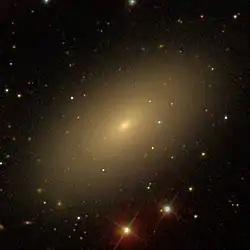| NGC 7457 | |
|---|---|
 SDSS image of NGC 7457 | |
| Observation data (J2000 epoch) | |
| Constellation | Pegasus |
| Right ascension | 23h 00m 59.934s[1] |
| Declination | +30° 08′ 41.79″[1] |
| Heliocentric radial velocity | 812 km/s[2] |
| Distance | 43 Mly (13.2 Mpc)[2] |
| Apparent magnitude (V) | 11.87[3] |
| Apparent magnitude (B) | 11.04[3] |
| Characteristics | |
| Type | SA0−(rs)?[1] |
| Other designations | |
| UGC 12306, MCG +05-54-026, PGC 70258[3] | |
NGC 7457 is an unbarred lenticular galaxy in the constellation Pegasus. NGC 7457 is its New General Catalogue designation. It was discovered by the astronomer William Herschel on 12 September 1784.[4]
NGC 7457 is estimated to be about 43 million light-years (13.2 megaparsecs) away from the Sun.[2] There are about 201 globular clusters in the galaxy.[2] The core of NGC 7457 is surprisingly bright and compact, with many stars.[5]
References
- 1 2 3 "Results for object NGC 7457 (NGC 7457)". NASA/IPAC Extragalactic Database. California Institute of Technology. Retrieved 28 March 2021.
- 1 2 3 4 Hargis, Jonathan R.; Rhode, Katherine L.; Strader, Jay; Brodie, Jean P. (1 September 2011). "The Globular Cluster Population of NGC 7457: Clues to the Evolution of Field S0 Galaxies". The Astrophysical Journal. 738 (1): 113. arXiv:1106.5058. Bibcode:2011ApJ...738..113H. doi:10.1088/0004-637X/738/1/113. S2CID 5846760.
- 1 2 3 "NGC 7457". SIMBAD. Centre de données astronomiques de Strasbourg. Retrieved 2021-03-27.
- ↑ Seligman, Courtney. "New General Catalogue objects: NGC 7450 - 7499". cseligman.com. Retrieved 2021-03-28.
- ↑ "Hubble Space Telescope Peers Into Core of Distant Galaxy". HubbleSite.org. 29 August 1990.
External links
 Media related to NGC 7457 at Wikimedia Commons
Media related to NGC 7457 at Wikimedia Commons
This article is issued from Wikipedia. The text is licensed under Creative Commons - Attribution - Sharealike. Additional terms may apply for the media files.